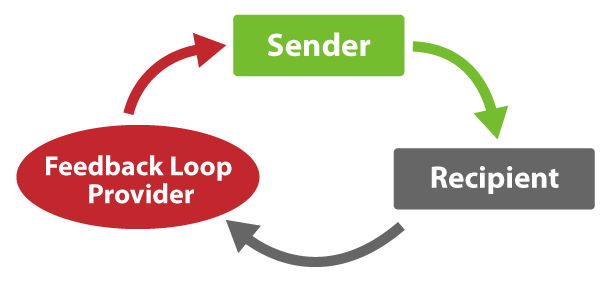
Email Feedback Loops: What Are They & How To Use Them
Are You “Out of the Loop”?
Ever heard the phrase, “Out of the loop?” It means a critical piece of information has been withheld from you (either on purpose or by accident) that you need to make a decision. No one wants to be left out of the loop, especially when it comes to things that can cost you time and money, like customer feedback.
And yet, many companies are sending email without any idea of what their customers are doing with it. A 2011 study by Return Path found that almost 20% of legitimate email never makes it to the Inbox, in part because of a lack of best practices such as handling spam complaints properly.
So how do you get access to the often-untapped treasure trove of customer feedback? Simple: get in the loop.
Sender, Know Thy Spam Complaint Rate
ISPs use many metrics to track how satisfied or dissatisfied their customers are with your emails and use that data when deciding whether to send your emails to the Inbox or Spam folder.
One of the primary metrics that ISPs use is your spam complaint rate. All other things being equal, the lower your spam complaint rate is, the more likely your messages are to go to the Inbox.
One way to reduce your complaint rate is to stop sending to subscribers who generate complaints. That way, you reduce the risk of having the same subscriber generate multiple complaints. This also stops you from sending to a subscriber who has indicated that they don’t wish to receive your mail (it’s a win-win).
So how do you know which subscribers generate spam complaints? You guessed it—by using email Feedback Loops (FBLs) to gather data (and a spam complaint processor to process it).
Email Feedback Loops and How To Use Them
Feedback loops (FBLs) are used by ISPs to notify senders when one of their subscribers marks an email as being spam. Here’s an example based on Outlook.com:
- Step 1: You register your mail server’s IP addresses with Outlook.com’s feedback loop and designate an email address to receive spam complaints at.
- Step 2: You send a campaign to your mailing list.
- Step 3: One of your subscribers clicks Outlook.com’s “Spam” button.
- Step 4: Outlook.com emails a notification of the complaint to the address you registered in Step 1.

This is just one example. There are many feedback loops available; some send information every time an individual subscriber generates a complaint, while others provide aggregate data. For example, Gmail may tell you your campaign received a certain number of complaints, but they won’t tell you which subscribers generated those complaints. (In this case, you can use the data to identify issues, but not to deactivate complaining subscribers.) At GreenArrow, we register each of our customers with feedback loops for 14 different ISPs. (Skip ahead to the Various Email Feedback Loops section if you’d like to see the entire list).
We recommend, at a minimum, each time you receive a complaint—you stop sending emails to the complaining subscriber. We also suggest you look at the complaint data in aggregate to identify and address potential deliverability issues. A spam complaint processor (described in the next section) can streamline this process.
Here are some examples of issues that can be identified during your analysis, along with potential responses:
- If your complaint rate for today’s campaign is twice as high as yesterday’s, it would be a good idea to look for what change(s) to your campaigns may have caused your complaints to increase.
- If you have multiple sign-up methods, and one of them generates a high complaint rate, take a close look at that sign-up method. Make sure that subscriber expectations are being set correctly: Do subscribers realize that they’re signing up to receive mail from you? Do they know how often those emails will be sent? Is your branding consistent?
Spam Complaint Processor: Automate & Analyze
Once you get your FBL set up, you’ll also want to set up a spam complaint processor to automate complaint processing. Sure, you could manually click the “Unsubscribe” link each time a complaint comes in—it’s certainly better than nothing. But a system like that is slow and prone to disruption, either by human error or a spam filter. You also run the risk that the ISP that sent you the spam complaint redacted some portion of the unsubscribe link, rendering it invalid.
A spam complaint processor, on the other hand, receives spam complaints from ISPs, extracts information about the message that triggered the complaint, then performs some action with this information. For example, out of the box, our Marketing Studio uses a spam complaint processor to deactivate complaining subscribers automatically. No manual clicking, no disruptions.
GreenArrow’s spam complaint processor also produces aggregate data, which can be useful for spotting patterns. The aggregate data includes:
- The number of complaints and overall complaint rate for each campaign.
- The complaint rate from each ISP. This report, which is generated for each campaign, breaks down the complaint stats by domain. For example, yahoo.com gets its own entry if one or more complaints are from yahoo.com subscribers.
(If you’re not using GreenArrow Studio, you can still use our spam complaint processor to automate subscriber deactivations. A member of our sysadmin team can work with you to get our spam complaint processor communicating with your application. We typically do this using GreenArrow’s Event Notification System.)
Various Email Feedback Loops
Each ISP’s feedback loop has its own setup process. The first step is often to fill out an application. You’ll include your contact information, what email address complaints should be sent to, and a list of what IP addresses or DKIM keys you wish to register. Don’t forget you must own the IP/domain, or have admin rights to register.
We include applying for and setting up feedback loops end-to-end as part of your setup process. As of July 2016, the feedback loops that we apply for include:
- Outlook.com (Hotmail)
- Yahoo
- AOL
- BlueTie
- Comcast
- Cox
- EarthLink
- FastMail
- OpenSRS (Tucows)
- Rackspace
- Synacor
- Terra
- Time Warner Cable (RoadRunner)
- USA.net
Most of the applications we send in are approved by their ISPs within a few hours, although it is common to have one or more of the ISPs listed above take a few days to approve or decline an application.
Our customers often opt to have us send in the feedback loop applications for them, but if you’d rather apply on your end, then our Feedback Loop Setup Guide describes the process in more detail.
Gmail’s Feedback Loop
Did you notice that Gmail was absent from the above list? Gmail technically offers a feedback loop, but it only provides aggregate data, so it can’t be used to deactivate individual subscribers. That said, you can get similar functionality to a feedback loop with Gmail by including a List-Unsubscribe header in your emails. Our Marketing Studio does this for you out-of-the-box, and our Transactional Email solution can be configured to as well.
Common Feedback Loop Pitfalls (and How To Avoid Them)
Feedback loop related issues can be broken down into two categories:
- You’re not receiving any complaints. A low complaint rate is exactly what you want, but even senders with amazing deliverability receive at least some spam complaints. If you’re sending millions of messages, but seeing zero complaints, then something is wrong. GreenArrow’s campaign stats include a “Spam Complaints” section, which summarizes the complaints that have come in.
- You’re not processing complaints correctly. With GreenArrow Marketing Studio, you can verify that subscribers are being deactivated due to spam complaints by searching for subscribers with a Status of “Spam Complaint.”
What next?
Knowing is half the battle, but to effectively manage your reputation with the ISPs, you need to take action.
Start with a double-check of your current software. Have you applied for the feedback loops listed above? Is your spam complaint processor set up to deactivate subscribers who no longer want your emails? Email feedback loops provide a valuable source of data, but it’s only when you apply that information that you can identify deliverability issues and reduce your spam complaint rate.
Have you worked with email feedback loops? Do you have other tips for our readers? Have questions for Matt? Or our deliverability team? Tell us about it.
[Our Team] The Freedom I Found In A $462 Mistake
I have to confess, I am thrifty. Ask my wife. She might say I’m a penny-pincher; I say ‘frugal’ and…
Six Essential Email Tools to Make Your Work Easier
Discover tools our support team says: ‘you shouldn’t go without.’ Over the past 5+ years working at GreenArrow, I’ve had…